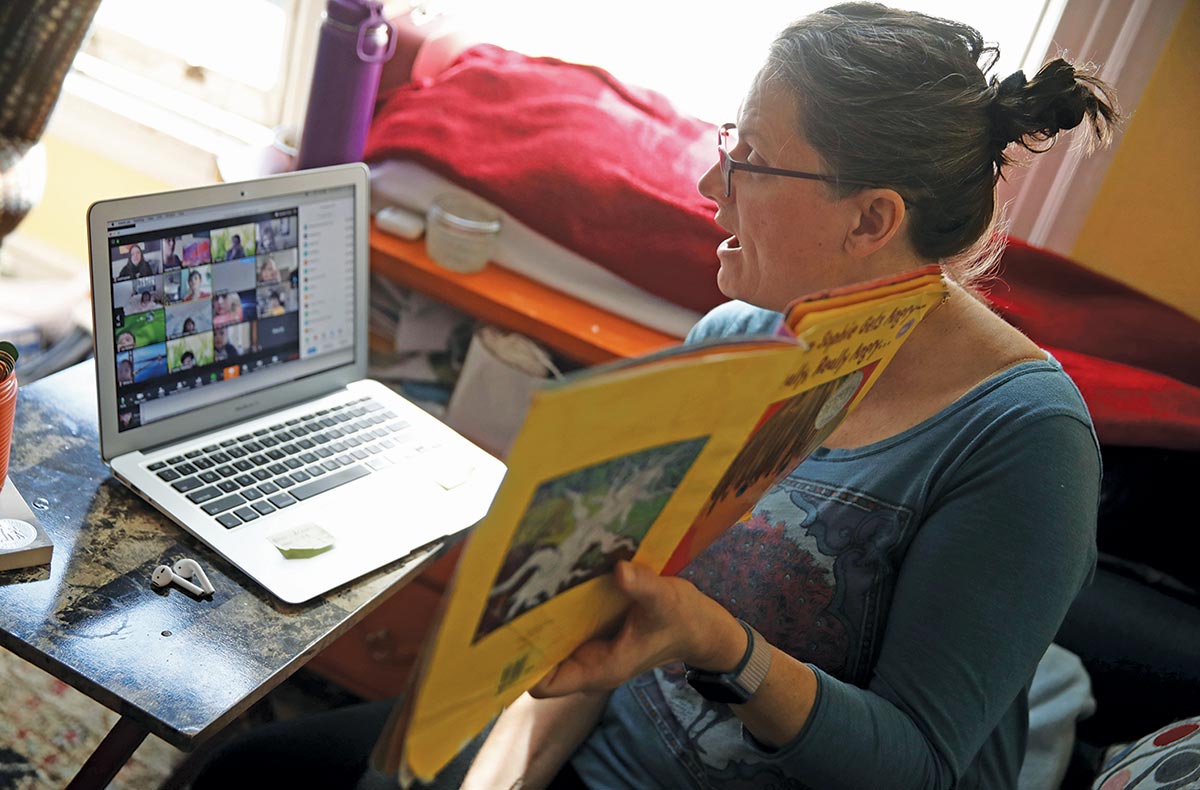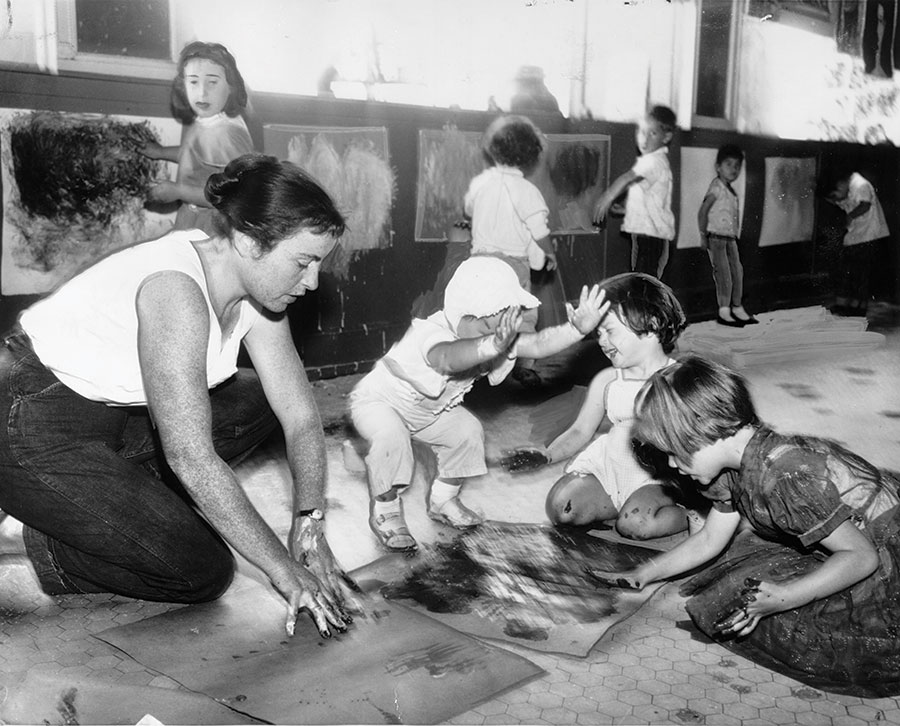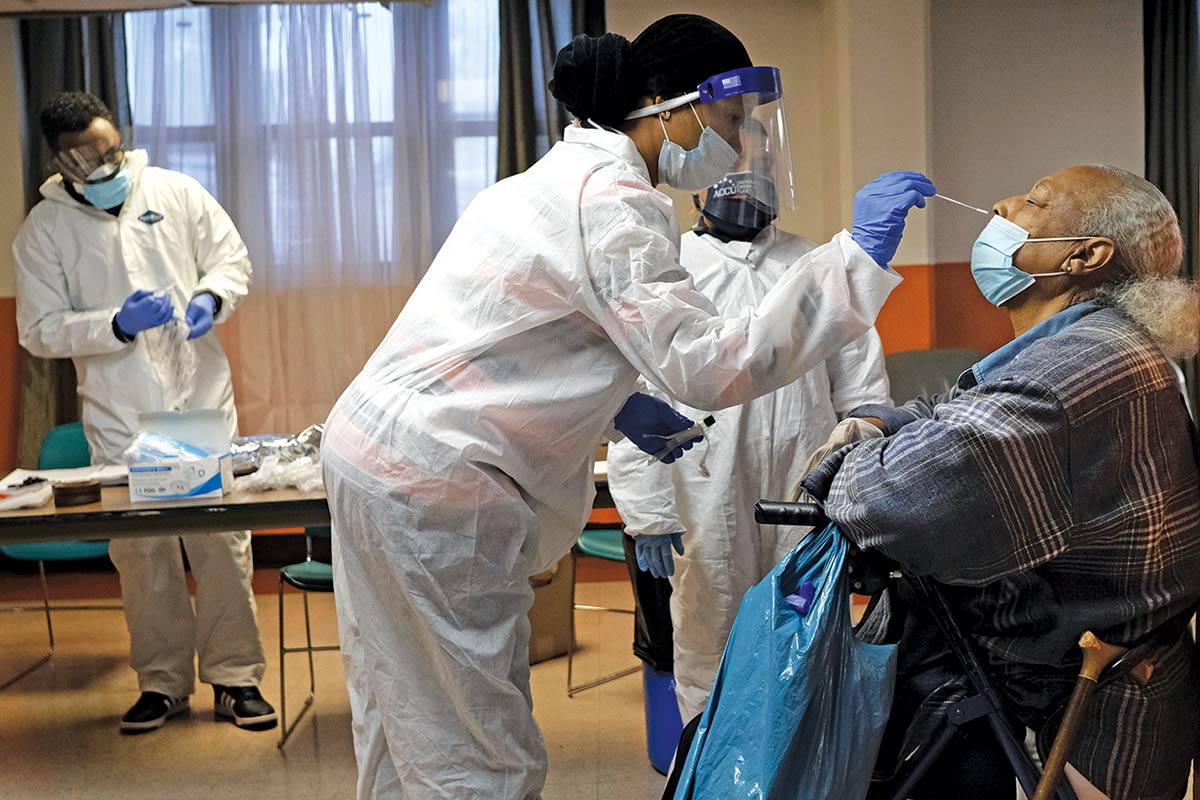Carmella Salinas tried to keep her preschool in New Mexico open for as long as she could. When the novel coronavirus started to spread through the United States, she began to take everyone’s temperature each morning and required staff to wear masks. Parents told their children not to give hugs. But it became untenable. “We’re constantly in contact with kids, their fluids,” she said. Salinas has chronic asthma and was worried what would happen if she got the virus. She decided to close. “We want to do whatever we can for our community, but at the same time, we have to look out for ourselves, too. It really is a difficult, difficult choice to make to leave your classroom.” She and her staff have been doing what they can to help the kids and their parents, offering them FaceTime sessions and filming YouTube videos of yoga or story time. One of her coworkers kept having to rerecord hers because she kept crying.
It didn’t get any easier when Salinas got an e-mail from the state encouraging providers like her to stay open. New Mexico deemed child care providers essential businesses, alongside health care providers and grocery stores. The silver lining, though, was the new honorific. “For us to finally be called essential workers…I’ve known it all along,” she said. But now her governor knows it, too. And parents are realizing just how hard it is to do what she does now that they have to do it at home every day. “I think this is honestly going to change a lot of the way the nation sees us.”
Care work—the in-person, direct services that keep people safe, healthy, and educated—has always been the underpinning of the rest of the economy. Child care allows parents to hold down jobs. Health care ensures that employees are healthy enough to go to work. Teachers nurture the next workforce. Elder care providers take care of our aging parents while we’re on the clock. This has “always been important,” said Paula England, a sociology professor at New York University. But the coronavirus crisis “really dramatizes the importance of the work.” It’s forcing us to reconsider how we value this work and the people who perform it. And workers are trying to turn that into lasting change.
Care work, said Purdue University history professor Tithi Bhattacharya, is “life making and life sustaining.” Yet it “receives the least amount of respect from capitalism.” England, University of Massachusetts Amherst economist Nancy Folbre, and fellow UMass Amherst sociologist Michelle Budig have found that even when they compare workers with the same education and experience levels, those who are in care jobs are paid less than those in other lines of work. Experts say one reason for that pay penalty is that care work is closely associated with women. “It’s seen as something that is part of what women are good at and what they naturally do,” explained Ariane Hegewisch, the program director for employment and earnings at the Institute for Women’s Policy Research. It’s been undervalued both because it was historically done inside people’s homes for free and also because it’s seen as something women just want to do and don’t need to be compensated for. “We kind of take it for granted, the same way we took for granted our mother’s love,” England said.
Popular
"swipe left below to view more authors"Swipe →
When performed outside the home, care work has often been done by black women. First, slaves cooked and cleaned in wealthy white households, and some provided child care. Later, domestic workers, who were overwhelmingly black, performed similar functions. Even today, people of color make up more than half of home health aides and about 40 percent of child care providers. The potent mix of the country’s “patriarchy and white supremacy,” as Melissa Boteach, the vice president for income security and child care at the National Women’s Law Center, put it, meant care work was consistently sidelined as a labor issue. Domestic workers have long been excluded from protections that applied to most other workers.
When American women moved into paid work in droves during the 1960s and ’70s—a significant share of black women had long been in the paid work force, but the percentage increased over that period, too—and tasks such as caring for children and the elderly became paid jobs, the country was swept up in culture wars over the roles of working women and motherhood. Instead of instituting a national universal child care system in the ’70s, President Richard Nixon cast the idea as destructive to the family. The country recoiled from the idea that the government should play a role in providing and funding care that mothers were “supposed” to do, leaving a private, patchwork system that can’t adequately compensate workers for the vital services they provide.
Some care workers have been folded into traditional employment relationships. Many nurses and teachers belong to unions and get benefits from their employers. Those employers—state governments, large hospital systems—have the resources to pay them more, even if they often devalue their employees. Others still operate outside the structures of traditional employment. But none of this work fits neatly into a capitalist system, which makes it difficult for workers to assert their bargaining power. “In a traditional market exchange, economists assume people are just self-interested,” Folbre noted. “But care work almost always requires some level of concern.” That means “you have women over a barrel,” Hegewisch said. Going on strike is fraught, because it can leave students or patients without the services they need. Workers in this sector certainly go on strike, as nurses and teachers have in recent years, but it often requires the buy-in and support of the people they serve to be successful. The wave of teacher strikes over the past few years worked, in part, because parents and students stood with their teachers.
Demanding better pay is also challenging because the benefits created by a job well-done don’t always create profits. What’s the monetary value of singing an engaging children’s song or taking the time to speak to a patient? The people who benefit from care work are not just those who consume it but all of us. And yet the people who directly pay for care often can’t afford to spend lots of money on it. The only way to adequately account for the collective benefit is to collectively pay for it.
Salinas has been working with young children for 18 years. It’s a tough job even under normal circumstances. She makes $20 an hour, and she knows that makes her lucky; child care workers make less than $12 an hour at the median. “You really have to love what you do,” she said. “You go home, and you don’t ever stop thinking about the kids. You wake up in the night, think about…better ways to educate them, to make them empathetic little people.”
Salinas doesn’t have health insurance or retirement benefits, and she’s become an activist to demand what she deserves. Every year she travels to her state capitol to lobby for more funding for child care providers and early childhood educators. “I’m telling senators and representatives we deserve to make more money because of all of the work we do,” she said. “A lot of the time we get, ‘OK, yeah, you’re a babysitter…. You can’t get paid that much.’”
“I feel awesome being called an essential worker,” she added. Now when she goes back to the legislature to ask for more funding, she’ll have something to point to. “Now there’s proof,” she said. And that is “creating a window for us,” noted Wendoly Marte, the director of economic justice at Community Change Action.
Nearly all care workers—nurses, child care providers, home health aides, nursing home employees—have been deemed part of the essential workforce. Health care workers get the added privilege of a round of applause every night and thank-you signs hung in people’s windows. Those things matter. “They’re our heroes and heroines,” Hegewisch said. With schools and day cares closed and nurses in short supply, people “are understanding that care work allows the rest of the economy to function,” said Boteach. “Sometimes it’s so invisible that you don’t see it until it’s gone.”
In a recent poll conducted by Caring Across Generations, huge majorities said they placed a greater value on the work of nursing home attendants, home health aides, and child care providers since the coronavirus hit. ”It’s the denial of interdependence that’s at the heart of the devaluation of care work,” Folbre said. And the current crisis has made it painfully obvious just how interdependent we are.
But just because we’re finally calling care workers heroes doesn’t mean we’re willing to pay them more. “The Hallmark card TV commercial [saying] let’s thank a caregiver—that’s insufficient in this moment. That’s not going to change the power structure,” said David Broder, the president of SEIU Virginia 512, which represents home health aides. “The way we talk about them has changed, but what those in power are doing hasn’t changed.” Governors may acknowledge that, for example, child care is key to ensuring essential workers can go to work, but not all of them have offered more funding to help providers stay open. “This is a pregnant moment,” agreed Jean Ross, a copresident of National Nurses United. But “it’s not magic. It’s not going to happen on its own.”
Workers see the opportunity. There’s been a surge of interest in organizing, unionizing, and even striking. Nursing home employees at 64 facilities across Illinois voted to strike in May to demand better pay and treatment. “We are just tired of being mistreated and disrespected and not being appreciated,” said Laverne Johnson, a nursing home employee in the state. “If the strike is what we have to do to make a point to them, to let them know that we mean business, then that’s what we’re going to have to do.” The strike was averted when management agreed to more protective gear and higher wages.
A year ago, said SEIU president Mary Kay Henry, the union ran a Facebook ad to organize workers in Denver and got about 100 responses. It just put out a similar ad and got six times the response. “I think the level of interest that working people have in joining together is at an all-time high,” she said. Ross, Broder, and Marte have experienced similar things. Broder’s union saw more growth in April than in any other month in its history. “There’s a hunger to be really engaged and be part of the fight in this moment,” Marte said.
The constituencies ready to fight for a revaluation of care work may have broadened. Finding quality child care, for example, is usually seen as parents’ individual struggle. Now it’s been laid bare that all parents deal with the same problem and are more or less affected the same way when it’s not available. Reha Sterbin, a mother in New York City, has noticed a change in the conversations in her parenting groups: People are talking much more about how to be good employers for their nannies, not just how to get by paying as little as possible. “We’re all suddenly home with our children all of the time; we are really missing having child care,” she noted. “Those conversations are coming up a lot more than they used to.”
Sterbin has employed nannies since her now kindergartner was a baby, and she joined Hand in Hand, a national network of people who employ domestic workers, in 2017 to protest the Trump administration’s family separation policy. But then the coronavirus hit. She realized that her nanny’s financial stability depended entirely on Sterbin’s good graces. “It’s become increasingly clear that our society values the work that I do way more than it values the work that she does, [but] caring for my children is just as important a job, if not more,” she said. “My anger at that is what’s driving me.” She’s now speaking at webinars for fellow employers and is planning to call her elected officials to press for better protections.
With schools closed, the desperate need for care is hitting families with older children, too. Parents of babies and toddlers have little bandwidth to organize to demand better child care; now they may be joined by parents of older children. “It’s a unique opening in the organizing space for people to [demand] that this whole system be rebuilt on a more solid foundation,” Boteach said.
One way to improve conditions for at least some care workers would be to “bring more into the formal economy,” Hegewisch said. Ai-jen Poo, executive director of the National Domestic Workers Alliance, noted that house cleaners, nannies, and home care providers don’t typically have paid sick days or other kinds of paid leave, so they were left with few protections when the pandemic hit. “Everyone who is working, playing a role in keeping us safe and…keeping the economy moving deserves a baseline,” she said.
Meanwhile, home health aides and child care providers have been fighting to unionize. Henry wants to see sectoral bargaining, or the creation of statewide tables that bring all home care or child care employers together so workers can bargain with all of them at once. She noted that California Governor Gavin Newsom recently extended protections and benefits to all food chain workers, unionized or not. “We’d love to see that happen in the care sector,” she said, “so we can make a permanent change to finally valuing this work once and for all.”
Care workers have already secured some tangible victories. The Minnesota legislature passed $30 million in grants for child care providers at the end of March—the most Marte and other advocates have ever been able to secure for child care in the state. In Virginia, when Governor Ralph Northam froze all new spending in the state budget in reaction to the crisis, he protected a previously approved increase in pay rates for home care workers.
They’re also thinking big. “This is the moment for us to call for bold solutions,” Marte said. Her organization has called for $100 billion in federal investment in child care—not just to help see it through the current crisis but also so that the sector is more stable well into the future. Broder’s members recently lobbied successfully in favor of a bill that would gradually phase in a $15 minimum hourly wage and benefit many of the low-paid home health aides he represents. While that figure used to feel “aspirational,” he said, aspirations have changed. “If we’re essential, then don’t talk to me about $15 in six years,” he said. “Talk to me about $20 today.”
It’s not clear if that kind of thinking has made its way into the halls of power. In its first round of stimulus to address the pandemic, Congress included just $3.5 billion for child care. Some Democratic senators have called for a $50 billion investment, but when the House passed another round of stimulus, it included just $7 billion more in funding for a sector that needs $9.6 billion a month merely to stay afloat during this crisis.
The pandemic has also led to increasing solidarity among different kinds of care workers. The crisis is “making it visually very clear who else is in this situation,” Broder said. Nurses are commuting to work on buses and subways alongside child care providers. Organizing together could be key to whether care workers can capitalize on this moment. “That should always have been happening,” Poo said, but now her organization is working with the SEIU, teachers’ unions, and other worker groups.
It may be the right time to press for large-scale change. “I would hope that what will happen is not just a revaluation of care workers but a revaluation of the whole care delivery system,” Folbre said. Single-payer health care would improve the health delivery system and could allow for better pay for providers. Universal child care would ensure parents can get the help they need while guaranteeing that providers earn decent wages.
The pandemic has made this change more urgent. But nothing is inevitable. The cratered economy is battering state budgets, making the prospect of more public spending appear dim. And yet the need is only going to increase. Parents need child care and schools in order to return to work and get the economy moving again. “There’s definitely a window of opportunity. There’s an opening,” Marte said. “But we have to make sure that the organizing is happening.” Bhattacharya sees the green shoots of mass movements in the ongoing wave of strikes that workers have staged during the crisis. “Just like the [1930s], it’s going to take massive movements, social movements from below, to force governments to change direction,” she said.
“There are always going to be people who very clearly want to take advantage” of care workers’ passion to serve, Folbre said. “You got to fight for it.”





